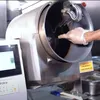Fill it, shut it, let it cook – this father-son duo’s patented device lets you cook fresh food easily
Want to cook an authentic Bengali poshto or a spicy Chettinad chicken? All you need is Rakaka Food Technologies’s plug-and-play device. Know more from Founder and CEO Jaikrishnan Ganeshan.
In 2014, when Jaikrishnan Ganeshan moved to Sweden to pursue a master’s in mechanical engineering at Linkoping University, apart from the challenges of moving to a new place and culture, he faced problems when he craved Indian food. Though there were a few Indian restaurants in town, but he found that the food lacked authenticity in taste as “it was made to cater to the tastes of European people”.
“This need for good food led to brainstorming with family and friends, and we came up with innovative solutions like having humanoids cooking with two robotic arms, a large churner to cook mass-scale Indian gravies, and so on. However, I realised that these ideas were impractical and learnt cooking to feed myself,” he says.
After six years of working in different domains and countries across Europe, Jaikrishnan returned to India but continued to think. He was now keen on innovating a product that simplified the cooking process, to save on both time and effort.
Plug-and-play for good food

The plug and play RFT device
“Digging deep, I felt the main problem that needed to be addressed was the question of ingredients for cooking. To make a simple pasta, one need to buy all ingredients in more quantities even if they were not needed. This is a problem for most people, especially students living on a tight budget,” he says.
Jaikrishnan and his father, RK Ganeshan, co-founded in 2018, Rakaka Food Technologies (RFT), whose first product is a simple plug-and-play device, which would be able to cook any dish by placing the right ingredients in the right quantities on a tray.
He explains the process. “We were inspired by how a VCD player functions. The device extracts the ingredients from the tray at the right time and heats the contents to the right temperatures. This makes the product global; irrespective of the cuisine, the process of cooking remains the same. The distinguishing factor are the ingredients (analogical to how a VCD work), which will be a separate entity.”
"The ingredients are placed in use-and-throw multi-compartment kits, which makes the post-cleaning process easy. “Once cooked, just discard the packets,” he says.
The device is IoT enabled for remote access and cooks recipes based on instructions extracted from the cloud software. The entire system - the ingredient kit, the automated cooking device, and the cloud technology (ITES) - is first of its kind and has been granted a patent.
The founders have launched a prototype and are eyeing a soft launch by the end of the year and a commercial launch by March 2022. They are advised and supported by P Chandrasekhr, a chartered accountant with more than 30 years of experience in diverse domains in Middle East.
Disrupting the foodtech space

The RFT ingredient kit
Jaikrishnan believes the target market will comprise early adopters in the demographic 22-35 years with a large disposable income.
He says there are other automated devices in the market, but a major gap still unaddressed by companies is the availability of fresh ingredients in a ready-to-cook box.
RFT also offers cloud-based memory that could bring in an unlimited number of recipes that can be cooked through this device. These include biriyani, millet bissi bela bath, aloo posto, ennai kathrikai, matar paneer, mutton rogan josh, Chettinad chicken, thirunelveli sodhi kozhambu, chicken peralan, Gujarati kadhi, Amritsari paneer, and more.
With in-house developed technology, RFT promises the end user fresh ingredients with a shelf stability of four to seven days with no chemical or physical processes.
The team comprising a chef, food technologist and quality expert has identified 100+ recipes that can be formulated on the device, out of which 60+ recipes have been tested. The foodtech team, in collaboration with CFTRI and IIHR, has formulated compositions of ingredients to match the shelf-life requirements.
Business and more
The founding promoters invested Rs 25 lakh during the ideation stage and later received funding of Rs 1.5 crore from three angel investors.
Rakaka Food Technologies suffered a temporary setback due to the COVID-19 pandemic, but the company hopes to cash in on the need for healthy alternatives and increased food safety. “The untapped market will be the growth driver for RFT,” he says.
The company will operate B2B2C, B2C, and subscription models.
“In the B2B2C segment, we would like to tie up with major PG accommodations, co-living spaces, and hospitals to sell our devices and generate revenue with our ingredients by directly targeting end customers. In this model, revenue generation would be two-fold: we sell the device to the firms and meal kits to the end consumer,” he says.
In B2C, the company aims to retail the device through online aggregators and retail touch points. One-time revenue would be generated and recurring transactional revenues would be generated due to the fresh ingredient kits.
“In the subscription model, we will deliver the device to the customer and bundle it with ingredient meal kits as a recurring monthly subscription package,” he says.
This year, a sales pilot was organised with Cookbasket, its standalone ingredient kits in South Bangalore.
“We have received a very good response for ingredient kits. We also received a grant of Rs 15 lakh from COE MSME in collaboration with IISC, Bangalore, for innovation in the foodtech space,” Jaikrishnan says.
Edited by Teja Lele








